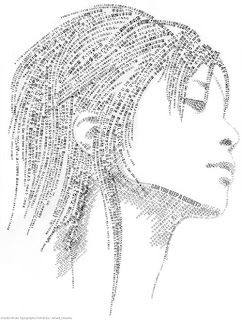One day I got carried away with a conversation. I wanted to ask my friend if she was going to eat her Apple Pie, I guess my brain didn't know in which language I should say it so I ended up asking her if she was going to eat her "apple of apple". This blog is an assignment for my art classes, yay! lots of fun :)
Tuesday, October 18, 2011
Thursday, October 13, 2011
Chapter 2-Barbara Kruger
Barbara Kruger
Barbara Kruger was born in Newark, New Jersey in 1945 (Today she’s 66). She attended Syracuse University, the school of visual arts, and studied art and design at Parson’s School of Design in New York. Kruger worked as a designer for Conde Nast Publications, later became head designer for Mademoiselle Magazine and after that she worked as a graphic designer, art director, and picture editor in the art departments at House and Garden, Aperture and other publications. She also did freelance work for other companies.
To me, Barbara’s work seemed quite simple and easy to recreate, but the meaning behind the piece makes the design much more impacting. She writes her statements on images that contradict her idea, making a two-sided argument on her images. Her messages are political, feminist, consumerist, and individualist.
Her design has influenced many forms of page layout that when we see her work we just know we've seen that arrangement somewhere else.The reason why I am drawn to her period and style is because this work is rebellious, it’s the truth that people don’t want to hear and a satire of society. For example, Renee Descartes Once said “I think, therefore I am” meaning that the only way he is sure he exists is because of his ability to think. Kruger on the other hand, takes his quote but makes a change.
Kruger’s work is not limited to museums and galleries, her work has been published on billboards, posters, a park, a train station platform in France and in other public commissions.
Tuesday, October 11, 2011
TyPoGrApHy =)
So for our previous Computer Graphics assignment, we were assigned to create an animal with type. Well it takes some work, you must figure out which animal, what font and what size is suitable. Then I go online and type in Typography on google and I came across sooo many awesome typography works.
There's more than one way to get such a thing accomplished. It can be nice and precise like the first one, loose with size variation like the second one, or totally varied like the third one which offers variation in color, size, and font yet it is all harmonized by creating a portrait. This type of work may be a little over done, but I'd like to try it sometime for fun =)
Sunday, October 9, 2011
Japanese tea pots
The porous texture, dark color, and organic form of the piece allows it to be perceived as a rock. Mass is also a component of this piece that makes it resemble a rock because of the color (or shadow?) at the bottom making it seem heavy.
I attempted to research more about "Muso", the idea that there is no such a thing as acceptance or rejection, which lead me to find about the poet and garden designer Musō Soseki who influenced much to the japanese gardening culture. Surely as a poet he was a deep thinker, and as a garden designer he observed aesthetics. Both qualities of his must have lead to his idea of acceptance and rejection.
source: http://www.jgarden.org/biographies.asp?ID=21
Tuesday, October 4, 2011
Subscribe to:
Comments (Atom)

























